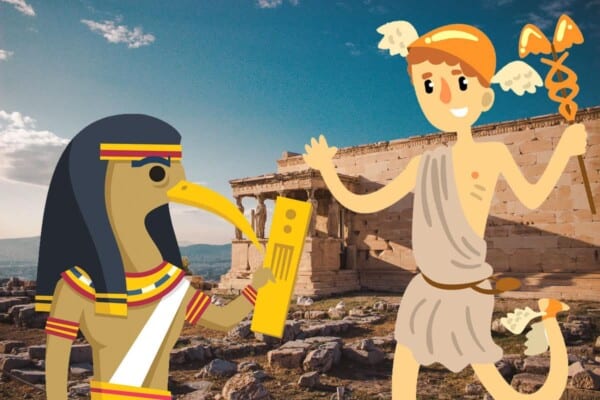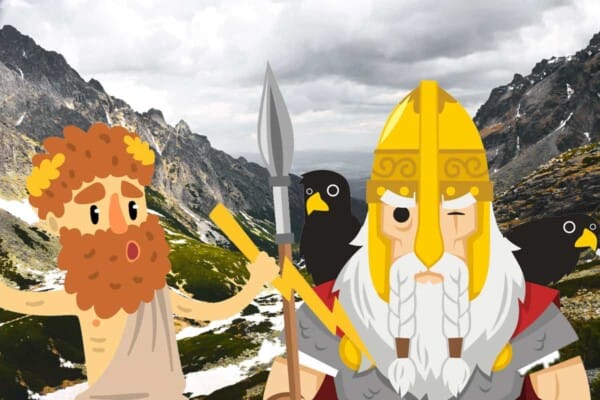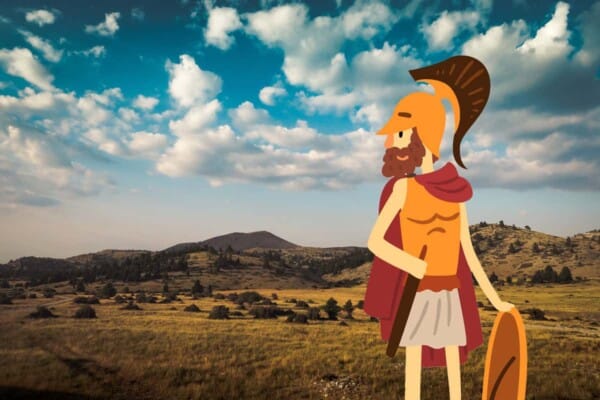Hades was the King of the Underworld and the god of the dead in Greek mythology. He was brother to Zeus and Poseidon, as well as Hera, Demeter, Hestia, and Chiron. He and his wife Persephone ruled the Underworld together as equals, making them extremely popular for modern interpretations of Greek mythology.
Unlike other figures, Hades did not have much mythology surrounding him directly. This was because the people, although they respected him and did not find him evil, were not particularly eager to draw the attention of death! These myths are some of his most significant.
Myths and Stories About Hades
1. The Acquiring of Persephone
Hades’s most discussed myth was how he won his wife, Persephone, the daughter of Zeus and Demeter. While the word ‘αρπαγή’ in Ancient Greek is often translated as ‘rape’, the actual meaning is more like abduction, kidnapping, or even acquisition.
Hades fell deeply in love with Persephone, but could not gain the approval of Demeter to take her daughter to the Underworld. He appealed to Zeus, who granted him permission to abduct Persephone from her garden. One day when she was picking grains, Hades appeared in his black chariot through a cleft in the earth and stole her away.
In the Underworld, he proclaimed his love and made her his bride. However, it was secret from Demeter, who searched the world for her daughter and neglected her duties as goddess of the harvest. Helios, the sun god, eventually revealed the truth to her. Demeter refused to feed the earth until Hades returned Persephone.
Zeus ordered that Hades obey, and he complied. First, though, he fed her pomegranate seeds. If a person ate the food of the Underworld, they were bound to the place forever. Hermes came down to fetch Persephone, but soon learned that she could only leave for half the year.
From then on, Persephone ruled for half the year at Hades’s side. For the other half, she spent her time in Olympus with her parents. During the time she was in the Underworld, Demeter caused winter.
2. The Punishment of Sisyphus
Hades was a relatively philanthropic god in Greek mythology. He was a god of riches and unseen things as well as the dead, and he sometimes shared these riches. However, to those who challenged the order of his realm, he reacted extremely harshly.
Sisyphus was a cruel man despised by the gods. He was the king of Ephyra, now Corinth, and was a great advocate of commerce. However, he was prone to murder and rape, and often invited travelers and visitors to his castle just to kill them and reestablish his own power. This broke the sacred xenia, guest right, which angered Zeus in particular.
Thanatos, the god of death, was ordered by Zeus and Hades to chain Sisyphus to a rock in Tartarus, the dungeon of the wicked in the Underworld. When Sisyphus saw Thanatos, he asked how the chains worked. Thanatos obliged in showing him, and Sisyphus tricked him into being chained up instead. This prevented anyone on earth from dying, and Sisyphus escaped.
Hades was furious. Ares, god of war, freed Thanatos as he missed the bloodshed. Hades and the Olympians cursed Sisyphus that his life would be so miserable he’d want to die. Before he did, though, Sisyphus made a final request of his wife – to throw his naked body in the middle of the public square.
When Sisyphus once again came to the Underworld, he persuaded the gentle Persephone that his wife had disrespected him. Feeling pity, Persephone sent him back to the world of the living.
A furious Hades sent Hermes to collect Sisyphus once and for all. When he did, Hades cursed him to spend eternity rolling a boulder up a hill. Every time he nearly reached the top, the boulder would roll back to the bottom again, simply to drive him mad and punish his hubris.
3. The Punishment of Pirithous
Pirithous was a Greek soldier and a friend of Theseus. When he and Theseus both lost their wives, the two friends decided that they would abduct Zeus’s daughter as their new brides. Theseus decided he would have Helen of Troy, the half-human demigoddess who was the most beautiful woman in the world. The two kidnapped the thirteen-year-old girl and left her with Theseus’s mother to wait until she was old enough to marry.
Pirithous targeted a more dangerous girl – Persephone, the wife of Hades. He and Theseus descended into the Underworld to steal her away. While they were there, Helen’s brothers, the Dioscuri, rescued her and brought her back home.
In Tartarus stopped to rest, and Hades, who could see all of his domain, discovered their plans. He sent his handmaidens, the terrifying Furies, to punish them, and encased their feet in stone so that they could never leave.
Eventually, Heracles freed Theseus, but Hades would not let Pirithous go – after all, he had committed the grievous crime of targeting Hades’s own wife. For this, Pirithous was bound to a chair where he slowly lost his memories and sense of self.
4. A Great Hero and a Good Dog
Hades’s closest companion was his three-headed dog, Cerberus, who was the guardian of the underworld. Cerberus was the son of the demon-giant Typhon and the monstrous Echidna. This made him sibling to Chimaera, the two-headed Orthros, and the Lernaean Hydra, who was later slayed by Heracles. However, Cerberus was much more benevolent to all except those who tried to escape the Underworld.
One of Heracles’s labors was to capture Cerberus from Hades. There are two versions of this myth. In earlier versions, Hades was outside the gates of the Underworld and refused to help, and was consequently shot by Heracles. In the more common version, Heracles descended into the Underworld and he, Persephone, and Hades came to an agreement.
Hades allowed Heracles to take Cerberus on the condition that the dog must not be harmed. Heracles agreed to this condition and did everything in his power to prevent it. Afterward, Cerberus returned to Hades’s side and resumed his post as guardian.
5. The Oracle and the Plague
Aonia was an area of the region of Boeotia, Greece, and it was hit by a terrible plague. It swept through the country, killing many and crippling others. The people consulted the great prophet at Delphi, known as the Oracle. The Oracle told them that the only way to fight the plague was by sacrificing two young virginal women to the gods of the Underworld.
Menippe and Metioche were daughters of Orion who had been raised by their human mother in Aonia and taught by Aphrodite and Athena. When they heard what the Oracle had commanded, they offered themselves as sacrifices. They performed the rites for sacrifice to the Underworld, then killed themselves.
Hades and Persephone accepted the sacrifice, but felt sorry for the two young women. Instead of bringing them to the Underworld, they transformed them into comets in the night sky.
Two children were born from the ashes of the girls, and their first act was to lead a funeral procession for their mothers.
6. Minthe and Leuce
Unlike most gods, Hades was almost entirely faithful to his wife, and she to him. The one story of her wandering eye is when she tried to claim the human, Adonis, from Aphrodite. Meanwhile, Hades’s attention was caught by only two other women, both nymphs.
Minthe was the daughter of the Underworld river known as the Cocytus. She loved Hades and attempted to seduce him. Depending on the myth, he either tolerated or returned her affections. In the latter case, Minthe lay in his bed and the two made love.
When Persephone realized what had happened, she complained to her mother. Minthe bragged that Hades loved her more and that he would banish Persephone in favor of herself. Either Demeter or Persephone responded to this by transforming Minthe into an herb, the first mint plant.
Leuce, meanwhile, was a daughter of the Titan Oceanus, and Hades’s first cousin. He fell deeply in love with her and brought her to the Underworld, where she lived out her whole life. Either Leuce came before Persephone, or Persephone tolerated Leuce as Hades’s concubine just as he had tolerated Adonis.
When Leuce died of old age, Hades turned her into the white poplar. This tree was sacred to the gods, and he placed it in Elysium as the highest honor. Leuce’s nature was sometimes seen as a doublet of Persephone, and when the two were combined they were seen as the goddess of regeneration.
7. Orphic Mythology and Zagreus
Zagreus was the son of Hades and Persephone. Depending on the myth, he occasionally had siblings: Macaria, Melinoë, Plutus, and the Erinyes or Furies.
In the Orphic versions of Greek mythology, Hades and Zeus were actually two aspects of the same god, and so Zagreus was a son of Zeus. This was extremely important, as he was known as the first birth of the thrice-born Dionysus. Dionysus was an incredibly important figure to Orphism.
The Orphic Zagreus was supposed to inherit the throne of Zeus. However, a jealous Hera gave him over to the Titans, who distracted him with toys then tore him to pieces and boiled them in a cauldron. He was partially eaten, but Athena saved the child’s heart and brought it to Zeus-Hades. Zeus later used this heart to ensure Dionysus’s rebirth through Semele.
8. God of Wealth
One of Hades’s epithets was Plouton, the god of wealth. From this name, the Romans derived Pluto, their version of the god. He was thus called because of his domicile under the earth, where gems and gold awaited his harvest. Hades was the most materialistically rich of the gods.
However, he was not at all selfish. Though people did not dare speak the name Hades, Plato encouraged the use of Plouton as ‘the giver of wealth’. He gave spiritual wealth to humanity in how all were born from the earth and all returned to it. He was also considered wealthy as all the souls of the dead belonged to him.
Other epithets of Hades in Greek included Moiragetes (the Fates’ guide), Agelastus (the melancholy one), Adesius (the graceful one), and Ophieus (the god who is blind)
9. The Unseen One
Hades’s name has generally been agreed from ancient times to be derived from a word meaning ‘unseen, invisible’. This was partly due to the fact that Hades was the least seen of the gods, very rarely leaving his Underworld domicile and even more rarely traveling to Olympus. As well, people on earth avoided speaking his name directly.
However, when Zeus was granted lightning bolts from the Cyclopes and Poseidon got his spear, Hades got another gift. This was known as the Cap of Invisibility or the Helm of Hades, and it literally could render its bearer unseen. Its power was a huge reason that Hades and the Olympians won the war against the Titans.
Hades occasionally loaned his helmet to others. His niece, Athena, borrowed the cap to hide herself from Ares during the Trojan War. She used it to heal Diomedes, who was then able to overcome Ares. His nephew Hermes also borrowed the helm, using it to defeat the giant Hippolytus.
He only loaned the cap to one human. This was the hero Perseus, a son of Zeus. Hades passed the helm to Athena (or possibly to the Stygian nymphs) with permission to loan it to the hero on his quest to slay the Gorgon Medusa. After Medusa was dead, Perseus used the cap along with the winged sandals of Hermes to escape her vengeful sisters, Stheno and Euryale.
Final Thoughts
Unlike in Christianity, the god of the Ancient Greek Underworld was not a Satanic figure. The Underworld was not a place of punishment, but rather the place where all souls congregated after death. Hades was feared and respected differently from other gods, and that’s how he liked it.














thanks this helped with my school project.